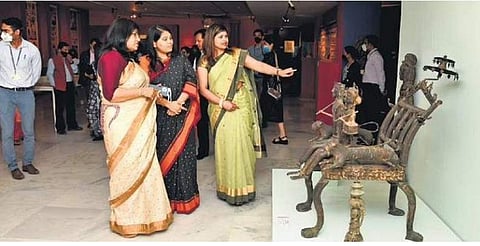
- LIFESTYLE
- FASHION
- FOOD
- ENTERTAINMENT
- EVENTS
- CULTURE
- VIDEOS
- WEB STORIES
- GALLERIES
- GADGETS
- CAR & BIKE
- SOCIETY
- TRAVEL
- NORTH EAST
- INDULGE CONNECT

The representation of women in India art and history tells us a lot about the evolution of culture. In order to give art enthusiasts an insight into the same, the National Museum, Central Secretariat, unveiled a new exhibition titled ‘Power, Patronage, and Piety – Celebrating Womanhood’ on the occasion of International Women’s Day on Tuesday. A suite of 100 visually-stunning paintings, artefacts, sculptures, and more, curated by Abira Bhattacharya, Assistant Curator, National Museum’s Department of Anthropology, and Sama Haq, Consultant, National Museum, explore the role played by women across history, and recognise the essence of womanhood. This exhibition is on display till April 8.
‘Power, Patronage, and Piety – Celebrating Womanhood’ was inaugurated by Lily Pandeya, Joint Secretary of the Ministry of Culture, Government of India, in the presence of Partha Sarthi Sen Sharma, Director General, National Museum, New Delhi. “The time is right and the time is now for immediate action to break the bias and end the inclusion and marginalisation of women and girls. To fully harness the power of women’s leadership in order to realise a more equal, more inclusive, and a more sustainable future,” said Pandeya in her inaugural speech. Shedding light on the theme of the exhibition, Haq shared,“Looking at this occasion [Women’s Day], we wanted to look at the prominent aspects—power, patronage, and piety, and locate them in Indian art. All the exhibits talk about women in dominant roles and dominant practices, starting from the Indus Valley Civilisation to the pre-modern times. Our idea was to create an equal and strong voice that is heard by everyone.”
Across religions and time periods
The constructs of power, advocacy, and devoutness have often been associated with masculinity in both religious and historical discourses. This exhibition shifts the limelight on women, representing female voices while exploring trans-cultural notions of Indian art and history. Through a series of objects such as sculptures, manuscripts, jewellery, tapestry, paintings, miniatures, ritual objects, among other such articles, the show also highlights masterpieces from various departments of the Museum.
Commencing with the famous Dancing Girl, a prehistoric bronze sculpture made during the Indus Valley Civilisation, the first section focuses on power. One can examine texts, icons, folk rituals, and oral traditions to understand the manifestation of God and godliness in Indian traditions. The second section is centred on literary texts and arts commissioned by former queens and princesses. By highlighting strong female protagonists in Indian medieval art, a dialogue is created between the idea of patronage and material culture. The exhibition finally concludes by focusing on religious discourse.
Of the many special artefacts that you will find at the exhibition is the ‘The bust of Vajra-Tara’, a stone sculpture of Buddhist deity Vajra Tara. Considered one of the most powerful female forms in the pantheon of Buddhist deities, the many characteristics of Vajra Tara bear resemblance with the Hindu goddess Durga. “[We have placed] The Vajra Tara to create an interface between Hinduism and Buddhism and [show] how things were getting influenced and how a linkage can be created between the two dominant religions,” explained Haq.
The section dedicated to patronage also features a few weapons and armours. “This section starts with depictions of education and moves to the weapons. The selection of weaponry depicts the queens and princesses who were taught various arts and how to handle battles, and armoury was one of the many skills that they were taught,” concluded Haq and Bhattacharya.
CHECK IT OUT
WHAT: Power, Patronage, and Piety – Celebrating Womanhood
WHEN: National Museum, Central Secretariat
WHERE: Till April 8